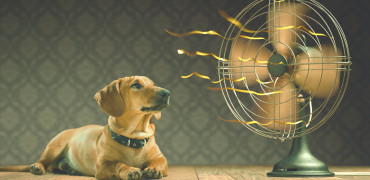Poor indoor air quality is a big issue at the moment – and will only get worse as our climate changes, but for those of you who have pets, the responsibility of a healthy indoor environment is imperative to your pet’s wellbeing.
The increase in pet hair, dander and pet odours will affect you, and vice versa the humidity from the kitchens, bathrooms, washers, dryers, chemical cleaners and other household smells will affect your pets.
How poor indoor air quality will affect your pets
Did you know that the lungs of dogs and cats are even more sensitive to environmental contaminants than ours? Pets like dogs also breathe more regularly than adults and children. This means our pets are vulnerable to more than just the same contaminants that affect us.
According to this article by BRE, people in Europe spend at least 90% of their time indoors, exposing them to pollutants including volatile organic chemicals (VOCs), gases such as nitrogen dioxide, ozone and carbon monoxide, particulate matter and fibres, and biological particles such as bacteria, fungi and pollen – all of which can cause detrimental health issues if levels rise too high.
These pollutants enter our homes through windows and doors and due to the air tightness of a lot of newer properties they struggle to leave, as effective ventilation systems are only typically installed in bathrooms and kitchens. In older properties, while often more leaky than new builds, deadly pollutants like asbestos, which has been banned for decades, can still sometimes make up the fabric of the house (it’s was very common in ceilings for example).
For pets that spend a high percentage of their time (likely 23 hours+ a day) in rooms such as living rooms and bedrooms, poor ventilation can potentially make the animal suffer. Furthermore, with most solvents like cleaning products settling on the floor, pets have a higher exposure due to their height, toys and bedding being close to ground level.
If you have a pet, there is also a high likelihood that you use flea collars, powders and shampoos with high chemical compounds containing pesticides which are reported to be cancer causing in both pets and humans. Organic and pesticide-free versions do exist so it’s always worth checking the label before you buy.
The most unfortunate part of all however, is that pets are unable to actively help themselves or communicate any signs of ill health, so it’s down to owners to recognise the signs – otherwise pets literally suffer in silence.
Another downside of a poor indoor environment for pets is overheating. In this previous article on the Hub by Ken Sharpe, he talks about warmer temperatures and improved construction (like the previously mentioned airtightness in new builds) leading to overheating in homes. Overheating in homes is both uncomfortable and unsafe, and as we all know heat stress in animals is serious.
For dogs, increased panting will be a sign of overheating but for other animal’s like cats, hamsters, rabbits and birds the signs are less obvious, so ensuring pets have sufficient water supplies and that cages/hutches are in cool places will help.
And of course it goes without saying that you should never leave an animal in a hot room, a sun trapped room or a car!
In case your pets do suffer overheating, this article on The Telegraph lists ways to keep pets cool and treat pet heat stroke.
How to improve indoor air quality
One of the best ways to tackle both indoor air quality and overheating in homes is with a system like mechanical ventilation with heat recovery (MVHR). A mechanical ventilation system allows homes to ventilate all rooms (not just kitchens and bathrooms) and with heat recovery, the stale air is removed but the temperature is maintained making it highly energy efficient. Some mechanical ventilation systems also offer free cooling – helping to reduce heat levels in summer.
The best mechanical ventilation systems also use filters to keep out external pollutants, so the air pumped into your home is far safer than that from an open window. Also filters can be easily changed so maintenance is minimal.
How to protect pets from the effects of poor indoor air quality
-
Plants
Indoor plants filter the air; just make sure you pick ones that are pet friendly like spider plants
-
Mechanical ventilation
Investing in mechanical ventilation means you can ventilate every room in the house including bedrooms and living rooms
-
Cleaning
Remember your pets will suffer the most from chemical cleaners. But regular hovering keeps the floor free of dust and mites, and regular washing of bedding will help too
-
Being mindful
Be mindful of lighting candles or smoking around pets (even while outside or on walks)
-
Being alert
Look out for signs of pets struggling. Poor breathing or even a decrease in motivation could be a sign
-
Being aware
Avoid walking dogs in high polluted areas or keep walks short when pollen count is high
Janvi Patel is a ventilation specialist at Mitsubishi Electric Living Environment Systems in the UK.



